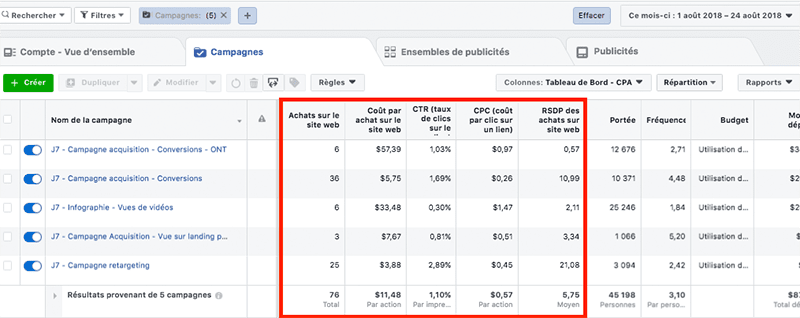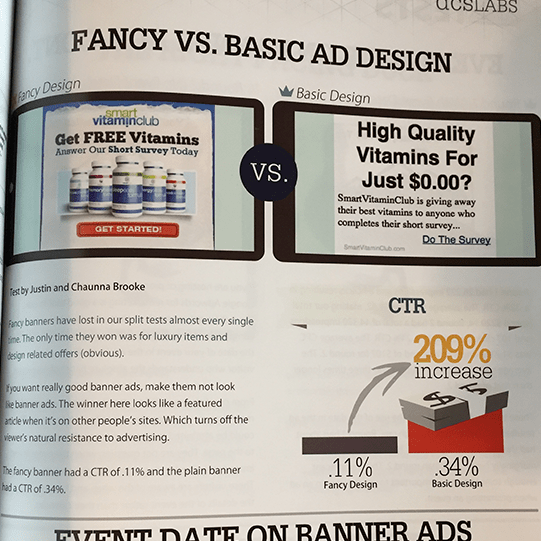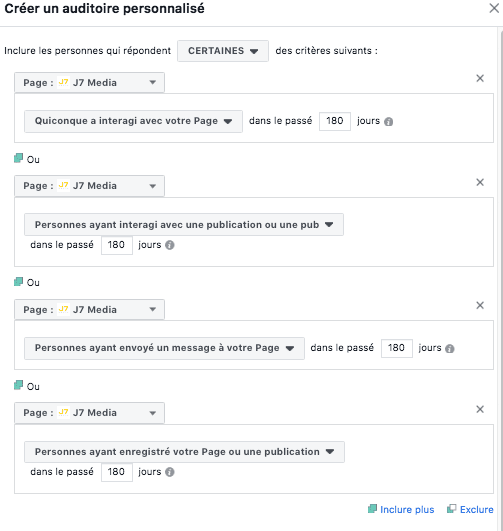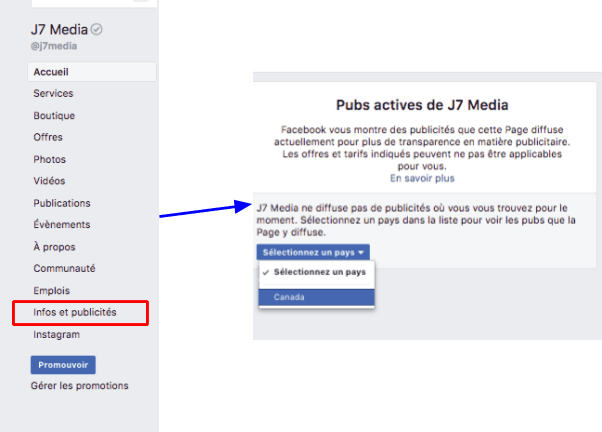Curious to know how to scale your Facebook Ads over $1,000/day? Get our experts' recommendations for free! All our clients went through this step!
7 ways to reduce your acquisition costs on facebook
7 ways to reduce your acquisition costs on facebook
What's amazing about Facebook advertising is how you can track absolutely everything which allows you to invest in the action that's important to you. An add to cart, a checkout initiated, a purchase, a sign-up, an appointment booking... A multitude of actions made possible thanks to the Facebook Advertising Conversion objective.
1 - framework for making good decisions when it comes to Facebook Advertising
Let's get a little more technical!
In order to make sound decisions when it comes to Facebook advertising, you need a good dashboard.
In this article, we’ll only talk about the conversion objective and therefore the cost per conversion/acquisition (CPA) and other key performance indicators that will allow you to make the best decisions.
I’ve already written an article on the subject, but here are the metrics that you should have in front of you:
Conversion & Cost per Conversion
No explanation needed when it comes to these two metrics, wouldn’t you agree?
Return on Ad Spend (ROAS or RSDP)
If your conversion leads directly to a monetary transaction with your prospect, it would be best to indicate this in your report. Considering that a single transaction can involve the purchase of several products, your CPA per number of purchases could be high but, given the resulting turnover, it would still be profitable!
You should be taking this metric into account, if possible!
Link Click-Through-Rate (Unique CTR)
Unlike the regular CTR, this one only applies to a click on the link or button that appears on your ad. Regular CTR applies to a click on a video, a click to enlarge an image, a click to see more text: a metric that is far removed from your reality!
We consider that a Unique CTR above 1% is considered a good metric.
Cost Per Link Click (CPC)
The Cost Per Link Click is the consequence of your Unique CTR or vice versa! If many people click on your ad, your Cost Per Link Click will be low and your Unique CTR will be high. In the opposite scenario, your Cost Per Link Click will be high.
Your dashboard should now look like this.
These are not the only key performance indicators that you should keep an eye on, but they remain the most important for our analysis.

2 - no conversions on Facebook
We’ll make this short.
Let's say you launched a campaign 4 days ago with a small budget (say 10$/day) and that you’re not getting any conversions.
In this case, you need to do a complete review of your campaign/ads/funnel.
Here are the potential reasons why :
- Your ads have not been approved
- Your ads are not delivering → You have to increase your bid
- Your ads/campaign have reached the delivery spending limit/budget that you set → Remove the spending limit
- You made a targeting mistake
- You have a wrong URL
- Your landing page/funnel does not have an embedded pixel or an error was made while setting it up → Have a look at the conversions in the Events Manager or troubleshoot the Pixel installation using Facebook Pixel Helper
- As you can see, the first thing you should do is to check if there is a technical error in your campaign that would prevent Facebook from working properly.
If you don’t come across anything that could explain this poor performance, you should probably stop your Facebook advertising/audience/campaign.
I’m not saying your campaign won’t work, but there must be an easier way for you to trigger a conversion. However, you do need to give yourself the means (budget) to do some testing.
3 - a high unique CTR, a low cost per link click, but a CPA that’s too expensive
In this scenario, we understand that many people click, but very few convert. You should therefore review your landing page/funnel.
A - Landing Page
Is your landing page performing well? That's the first thing you should check. To do this, you have three things to set up.
A/B Testing
The first one is the Split Test or A/B Testing.
This simply involves testing different versions of your landing page (as well as all the ones that are linked to it) to increase your conversion rate at each step.

Beware, I'm not talking about simply changing the color of a button; sometimes you have to test two very different versions in order to be able to move forward quickly
To give you a few ideas, I would recommend that you order the book “108 Proven Split Test Winners” written by the famous Russel Brunson, available here.

It’s a free book (you’ll just have to pay the shipping costs), but it gives you a lot of examples to set up on your website.
B - Ad Scent
Ad Scent is a term that refers to the concordance between an ad and its redirect page.
Understand the following: the more you ask your prospect to perform actions (click, fill out a form, etc.), the more likely it is that he will stop. Out of weariness, lack of time…
Every time you redirect him to another page, the prospect has to readapt to a new universe, a new layout, and that requires effort! You have to mitigate the effort required as well as all potential friction between your prospect and the conversion.
If your ads’ colours are mostly composed of orange tones, it would be a mistake to send your prospect to a page that’s completely purple. Your prospect’s click is based on a certain discourse, a colour, an emotion; he wants to find them all along the funnel.
Our goal is to get your prospect in a state of "Flow". That is to say, everything is easy, time has no more effect on him, only the completion of the action matters. To better understand this last concept, I strongly encourage you to watch this amazing Flow video by El Gamificator.
C - Copywriting
Just because the person clicked on your ad doesn't mean that they're convinced about your business. It's all about your landing page!
This is part of A/B Testing, but I wanted to tell you more about a method and a book that I recently discovered: How To Write Copy That Sells by Ray Edwards.
In his book, Ray discusses various techniques to write a good email, a good ad or a good landing page. One of his methods struck me: P.A.S.T.O.R.
The PASTOR method encourages you to write your texts using the following model:
- Problem, Person
- Amplify Situation
- Story/Solution
- Offer
- Response
This method is effective because it’s easy to understand and replicate, even without having any writing skills. I won't say anything more about it; if you’re curious he discusses it in great detail on his Podcast.
D - Audience
Although I'm very curious about digital marketing and click on many Facebook ads, I don't usually convert to a $150 program on the first try.
Understand one thing, if you don't have a conversion at the desired price, it’s possible that :
Your audience isn’t ready
It needs to be warmed up with educational content that highlights its problem so that it decides to solve it.
Your audience isn’t profitable
Sometimes, an audience can be one that consumes a lot of content but never buys anything.
You will have to test new cold audiences (based on interests).
I would also advise that you test lookalike audiences that are different from your visitors/customers: your Facebook page, for example.
If you have a good engagement rate and fans on your page, go to Audience > Create an Audience > Custom Audience > Engagement > Facebook Page.
You should retrieve a significant number of people, which will allow you to create a lookalike audience that may be more reliable.

4 - a low unique CTR, a high cost per link click, and a CPA that’s still too expensive!
As you will have understood, the problem here is not your landing page, but rather your ads. If your CPA is high, it's because few people get close to the conversion stage.
So give it all you’ve got once and for all!
A - Your Ad Copy
We've often discussed ad copy at J7 Media. First of all, be aware that the text comes before the image. The latter is the illustration of one of the arguments contained in your text.
Then, during a Live and in an article, we gave you a 5 step process for writing Facebook Ads copy that will get you more clicks.
Here is a summary:
Call to Customer Avatar
Speak to your target directly, write in capital letters and include emojis! You must not go unnoticed.
Question
You should intrigue your target by asking him a question about his situation. Very often, we tend to think that the person who brings up a problem has the solution.
Answer
Without giving away too much, as you need arguments for later.
Presentation
Tell your target who you are and why you're in this business.
Solution
Explain to your target how you can help him solve his problem, beyond the initial solution that you’ve already given him.
Call to Action
Don’t assume that your prospect knows how to contact you, put it in writing! Again, try to avoid any deterrents or unnecessary effort for your prospect.
Also, don’t hesitate to test different lengths for your ad copy; long texts (which requires one to click to see everything) and short ones.
B - Your Ad Visuals
Of course, visuals can detract from the performance of your ads.
You can’t stick to just one, you must do some testing:
1 - Different formats, including video, to which we’ve devoted an entire article.
2 - Different angles according to your text.
- Painkiller: emphasize the problem, your prospect’s pain point.
- Vitamin: highlight your prospect’s desired outcome.
3 - Your competitors’ concepts if they seem relevant and adaptable to your brand image.
Facebook has made it easy to do so since it decided to provide advertising transparency and made it possible for one to search for a business page and view its ads without even being part of the target audience.

4 - Get inspiration from concepts used in other industries and test your ideas with other people, whether they’re Facebook experts or not!
That’s a method that we were able to test with our Unique CTR Challenge: working off the same client brief, two experts have very different ideas and none of them is inherently bad!
It’s therefore interesting to compare and test your ideas with others in order to come up with better ones.
C - Your Ad’s Audience
Again, your audience might be problematic.
You may be targeting people whose need is not as strong as you thought, or even who don't have that need at all!
That's why we tend to test several audiences right from the start in order to find the best one quickly.
Conclusion
I hope that in the course of this article you’ll have understood the following.
First of all, your dashboard in the Manager shows the symptoms that are eating away at your advertising. Therefore, it is by referring to it that you will know which body part needs to be examined:
- The campaign itself, if nothing is working
- The ads, if not many clicks are recorded
- The landing page or the funnel, if conversion is expensive despite getting a large number of clicks
I’m repeating myself by now, but these are not the only metrics that should be taken into account. Depending on the case, the frequency of your ads may be a factor. If you’re delivering to a limited audience, Facebook may not have enough volume to optimize your results.
Moreover, you may need to constantly call your audience into question. That’s why your work on the Persona is PRIMORDIAL to understand:
- The problem
- The pain point
- Your prospect’s desired outcome
At J7 Media, that’s what we focus when we first start working with a client. Because it's what drives all our efforts afterwards!
One last thing; nothing is written in stone and everything should be tested over and over again. And if you can't achieve your goal after several tests, go for an easier conversion (e.g. from purchase to add to cart). Remember that Facebook needs 50 conversions per week to be able to optimize and give you better results later on.
If you’re having trouble getting 10 conversions a week, your objective needs a bigger budget and/or better ads/targeting/funnels.
See you soon for another article!
You can further expand your knowledge by reading : Boosting your Sales on Facebook with a Lead Magnet.

